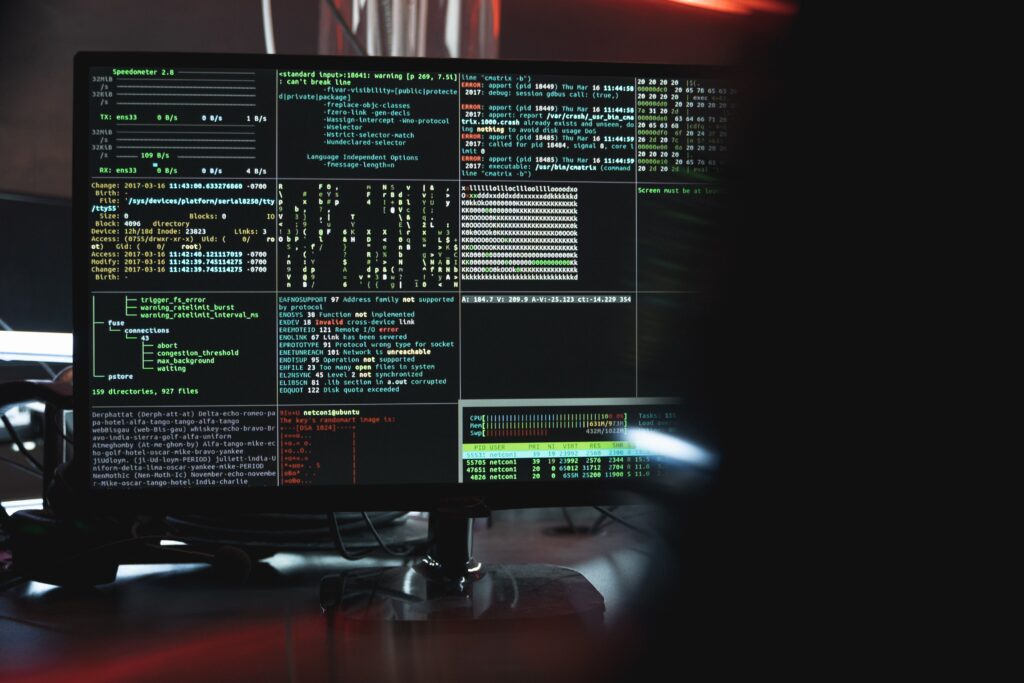Cybersecurity is establishing itself as a top concern for all parties, including people, businesses, and governments, in our increasingly digital environment. The sophistication and frequency of cyber threats are increasing, making it difficult to protect against them alone with conventional techniques. In this situation, artificial intelligence (AI) can revolutionize cybersecurity. In this thorough investigation, we will delve into how AI functions in cybersecurity, talk about its application, clarify the benefits it provides to people, assess its current condition, and speculatively predict its future.
How AI Works in Cybersecurity
Artificial intelligence in cybersecurity works by utilizing machine learning and advanced analytics to identify and stop online threats. Here’s how it works:
- Data Collection:
- AI systems collect vast amounts of data from various sources within an organization’s network and external feeds.
- This data includes network traffic logs, system logs, user behavior data, and threat intelligence feeds.
- Data Preprocessing:
- Raw data is cleaned, normalized, and structured to make it suitable for analysis.
- AI algorithms can handle these preprocessing tasks efficiently and effectively.
- Anomaly Detection:
- AI models, particularly those using unsupervised learning, analyze data to establish a baseline of normal behavior.
- Deviations from this baseline are flagged as anomalies, which could be indicative of a cyber threat.
- Pattern Recognition:
- Machine learning models are trained to recognize patterns associated with known threats, such as malware signatures or attack vectors.
- These models can identify known malicious activities based on historical data.
- Behavioral Analysis:
- AI can analyze user and entity behavior to identify unusual or suspicious actions.
- For instance, it can detect unauthorized access attempts or data exfiltration.
- Real-time Monitoring:
- AI continuously monitors network and system activity in real time, allowing for immediate threat detection and response.
- This proactive approach is crucial in mitigating threats before they cause significant damage.
- Response Automation:
- AI can automate responses to certain types of threats, such as isolating compromised devices or blocking malicious IP addresses.
- This reduces response time and minimizes human error.

Implementing AI in Cybersecurity
Implementing AI in cybersecurity requires careful planning and consideration of several key steps:
- Data Collection and Integration:
- Organizations need to gather data from various sources, including firewalls, intrusion detection systems, and endpoint devices.
- Integration tools and data lakes are used to centralize and manage this diverse data.
- Model Selection and Training:
- Choose the appropriate AI algorithms and models based on the organization’s specific needs and available data.
- Training the models involves using historical data to teach the AI system to recognize threats.
- Real-time Monitoring and Analysis:
- Implement real-time monitoring solutions that continuously analyze network and system activity.
- AI should be able to process this data quickly to identify threats as they occur.
- Response Orchestration:
- Develop automated response playbooks that specify actions to take when a threat is detected.
- Ensure human oversight is maintained for critical decisions.
- User Education:
- Train employees and IT staff on how AI-based cybersecurity systems work and how to respond to alerts and incidents effectively.
- Create a culture of cybersecurity awareness.
- Scalability and Integration:
- Ensure that AI cybersecurity solutions can scale with the organization’s needs.
- Integrate AI with existing cybersecurity tools and processes.

Benefits for Individuals and Organizations
The integration of AI in cybersecurity brings numerous benefits to individuals and organizations:
- Improved Threat Detection:
- AI can identify threats that traditional signature-based systems might miss.
- It excels at detecting zero-day vulnerabilities and previously unknown attack patterns.
- Real-time Response:
- AI can respond to threats in real time, reducing the time it takes to contain and mitigate an attack.
- This minimizes potential damage and data loss.
- Reduced False Positives:
- AI’s ability to analyze data patterns leads to fewer false-positive alerts, allowing security teams to focus on genuine threats.
- This reduces alert fatigue among cybersecurity professionals.
- Enhanced User Behavior Analysis:
- AI can detect insider threats by analyzing user behavior and identifying unusual actions or deviations from normal patterns.
- This helps organizations prevent data breaches from within.
- 24/7 Security Monitoring:
- AI-driven cybersecurity operates round the clock, providing continuous protection even during non-business hours.
- This is especially critical in a globalized digital landscape.
- Cost Efficiency:
- Automating threat detection and response can reduce the need for a large and constantly vigilant cybersecurity team.
- This leads to cost savings for organizations.

Implementation in Today’s World
AI in cybersecurity has already gained significant traction across various industries. Here are some real-world examples of its implementation:
- Endpoint Security:
- Many organizations use AI-driven endpoint security solutions to protect individual devices such as computers, smartphones, and IoT devices.
- These solutions detect and prevent malware, ransomware, and other threats at the device level.
- Network Security:
- AI is employed in network security to monitor network traffic and identify unusual patterns that may indicate a cyber-attack.
- Intrusion detection systems (IDS) and intrusion prevention systems (IPS) leverage AI to enhance network security.
- Email Security:
- AI is used to analyze email content and attachments to identify phishing attempts and malicious links.
- It can also flag suspicious email behavior, such as large-scale email forwarding.
- Cloud Security:
- Cloud providers offer AI-based security services that monitor and protect cloud-hosted applications and data.
- These services can detect and respond to threats in cloud environments.
- Threat Intelligence:
- Organizations subscribe to threat intelligence services that use AI to gather information on emerging threats and vulnerabilities.
- This information helps organizations proactively defend against new threats.
- User and Entity Behavior Analytics (UEBA):
- UEBA solutions leverage AI to analyze user behavior across an organization’s network.
- They can detect insider threats, compromised accounts, and unusual activity.

The Future of AI in Cybersecurity
As technology advances, the use of AI in cybersecurity is likely to be both exciting and difficult in the future. Our capacity to identify and counteract cyber threats has already advanced significantly thanks to AI, but its role is anticipated to grow and change in the following ways:
- Adaptive AI Defenses: AI will evolve to become even more adaptive, learning and adjusting to new threats in real time, making it exceedingly challenging for cybercriminals to find vulnerabilities.
- Quantum-Resistant AI: With the looming threat of quantum computing, AI will need to develop quantum-resistant algorithms and encryption methods to secure sensitive data.
- AI-Driven Deception Tactics: AI will be used to create sophisticated deception tactics, luring hackers into traps and exposing their tactics, techniques, and procedures.
- Deepfake Detection: AI will play a pivotal role in developing advanced deepfake detection methods to combat the rise of AI-generated fake content used for cyberattacks.
- AI Ethics and Regulation: The ethical use of AI in cybersecurity will be a focal point, leading to the development of robust regulations and guidelines to ensure responsible AI deployment.
- AI Collaboration: Collaboration between AI systems will become commonplace, creating a networked defense ecosystem where AI entities share threat intelligence in real time.
- AI in Autonomous Cybersecurity: Fully autonomous AI-driven cybersecurity systems will emerge, capable of making complex decisions without human intervention.
- Enhanced User Authentication: AI will revolutionize user authentication by incorporating behavioral biometrics and continuous monitoring to ensure secure access.
- AI in Insider Threat Detection: AI will play a pivotal role in detecting subtle insider threats by analyzing vast amounts of user behavior data and identifying anomalies.
- AI-Powered Hacking: Unfortunately, cybercriminals will also harness AI, using it to devise more sophisticated and adaptive attack strategies, leading to an ongoing AI arms race in cybersecurity.
- AI-Enhanced Security Awareness: AI will aid in improving security awareness by providing tailored training and simulations to educate employees and individuals about evolving threats.
- AI-Powered Incident Response: AI will not only detect threats but also orchestrate incident response, automating containment and recovery actions with minimal human intervention.
- AI-Driven Security Analytics: Advanced AI analytics will uncover hidden patterns and correlations in vast datasets, facilitating proactive threat hunting and risk assessment.
- AI-Embedded IoT Security: As the Internet of Things grows, AI will be integrated into IoT devices and networks to protect against vulnerabilities and breaches.
- Global AI Cybersecurity Standards: A global effort to establish standardized practices and protocols for AI cybersecurity will emerge, ensuring consistency and effectiveness worldwide.
The incorporation of AI in cybersecurity marks a significant advancement in the fight against a constantly changing world of online threats. It improves threat detection, reaction times, and the general state of an organization’s and an individual’s security. The ethical and legal issues surrounding AI in cybersecurity must not be undervalued, though, because with tremendous power comes great responsibility.
With improvements in threat intelligence, autonomous security, and integration with cutting-edge technologies like quantum computing and the Internet of Things, AI’s position in cybersecurity will only grow in the future. For everyone to live in a more secure digital future, it is critical that businesses, cybersecurity experts, and politicians collaborate to fully utilize AI’s potential in cybersecurity while solving its accompanying concerns.
